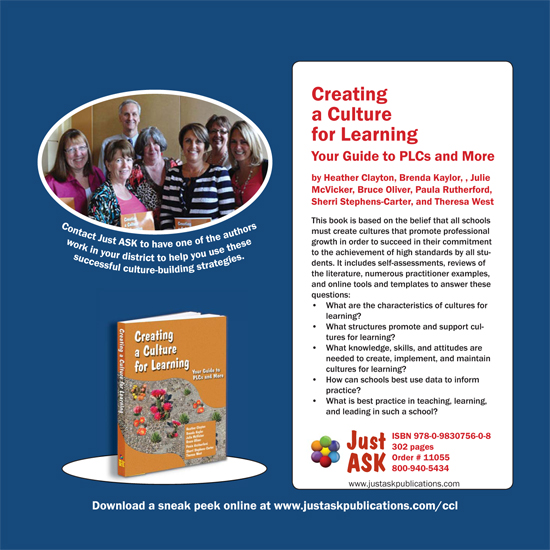
Volume V, Issue III
|
Heather Clayton, the author of Making the Standards Come Alive!, is the principal of Mendon Center Elementary School in Pittsford Central School District, New York. She is also a co-author of Creating a Culture for Learning published by Just ASK. |
Power Standards: Focusing on the Essential
“If everything is important, then nothing is.”
– Patrick Lencioni
Each day, teachers are faced with the enormous responsibility of teaching, assessing, and responding to students learning across a high number of dense standards within a limited number of school days. Dr. Robert Marzano, a leading researcher in education, claims that in order to cover all of the content required in many states’ standards, schooling would need to be changed from K-12 to K-22. Marzano states that “The sheer number of standards is the biggest impediment to implementing standards.”
It is not realistic to think that teachers can reach students when they are merely covering all of the required standards and moving on, even when some students haven’t grasped the content and skills. Very often, teachers operate under the assumption that all standards are equally important and that they have to ensure that students are taught all of the standards with the same level of intensity each year.
The danger of delivering standards that are an inch deep and a mile wide is that students will inevitably leave a grade level or course with gaps in their learning. It is then the next teacher’s responsibility to reteach what students should have learned, in order to ensure the prerequisite knowledge and skills required for success in their current grade level or course.
Rationale for Prioritizing Standards
The key is “prioritization” not elimination.” By giving priority to certain standards, teachers can provide in-depth instruction and target their support for students.
The solution to this dilemma is to prioritize certain standards and performance indicators, rather than giving each of them an equal amount of attention in the curriculum and on assessments. The key is “prioritization” not “elimination.” By giving priority to certain standards, teachers can provide in- depth instruction and target their support for students.
- When teachers collaboratively prioritize their standards they gain clarity around what the students are expected to have learned upon leaving the grade level/ course.
- The process of prioritizing standards requires teachers to look at the standards vertically. This vertical alignment allows teachers to identify important prerequisite skills students need before tackling current grade level/course standards.
- The clarity and prioritization of standards lends itself to higher quality assessments. Assessments become aligned, purposeful, and essential in identifying those students in need of intervention, remediation, or enrichment.
- When standards are prioritized, it is easier for teachers to choose high quality resources to support their students’ learning. With so many resources at our fingertips, narrowing the focus ensures that the work students are doing is targeted and effective.
- It is far easier for teachers to go in depth when they have fewer priority standards. Rather than broad coverage of material, teachers can focus on deepening students’ understanding of essential content, strategies, and skills. Similarly, teachers have a much richer understanding of the content they teach.
- The process of prioritizing the standards is a valuable one for teachers. When teachers collaboratively debate and discuss the significance of the standards they teach, they develop a rich understanding of how the standards build vertically and support students’ readiness for the next unit of study, grade level, or course. At last, teachers have clarity around what is essential to teach.
- If a collaborative approach to prioritizing standards is not used, then teachers are forced to choose what they feel is essential. Often those decisions are based on a teacher’s comfort level, availability of resources, or personal preferences. This approach does not give all students access to a guaranteed and viable curriculum.
- The prioritization of standards distinguishes the standards that are essential for student success. We call these prioritized standards “power standards.”
- Dr. Douglas Reeves from The Leadership and Learning Center, explains power standards as those that are critical for student success. Reeves’s definition is “those standards that, once mastered, give a student the ability to use reasoning and thinking skills to learn and understand other curriculum objectives.”
Criteria for Selection of Power Standards
EnduranceWhen the standard represents learning that goes beyond one course or grade level and is representative of a concept or skill that is important in life, it has endurance. |
LeverageWhen the standard represents learning that is applied both within the content area and in other content areas, it has leverage. |
ReadinessWhen the standard represents learning that is essential for success in a new unit, course of study or grade level, it has readiness. |
Endurance
When the standard represents learning that goes beyond one course or grade level and is representative of a concept or skill that is important in life, it has endurance.
- Does this standard have value beyond one single test date?
- Will this standard endure beyond the test?
- Will the knowledge and skills be important beyond this unit?
Examples of standards with endurance:
Elementary
RI.4.1
Refer to details and examples in a text when explaining what the text says explicitly and when drawing inferences from the text.Secondary
RI.9-10.1
Cite strong and thorough textual evidence to support analysis of what the text says explicitly, as well as inferences drawn from the text.This standard endures far beyond one test, as students will need to read informational texts proficiently and substantiate their claims using evidence from the text when reading, writing, and speaking to a variety of audiences and for a variety of purposes. Students will cite textual evidence with increasing levels of sophistication throughout all of their years of schooling and will need to know how to do so in order to be college and career ready.
Leverage
When the standard represents learning that is applied both within the content area and in other content areas, it has leverage.
- Does this standard have multidisciplinary connections?
- Is this standard relevant in other disciplines?
Example of a standard with leverage
Elementary
W.5.1.
Write arguments to support claims in an analysis of substantive topics or texts, using valid reasoning and relevant and sufficient evidence.Secondary
W.11-12.1
Write arguments to support claims in an analysis of substantive topics or texts, using valid reasoning and relevant and sufficient evidence.The ability to write an argument and support claims with valid reasoning and evidence provides leverage in other content areas. For instance, students may be writing scientific, historical, or numerical arguments that they substantiate with evidence learned in specific content areas.
Readiness
- When the standard represents learning that is essential for success in a new unit, course of study or grade level, it has readiness.
- Does this standard contain prerequisite content and/or skills necessary for the next unit, course of study, or grade level?
Examples of standards that support readiness
Elementary
1.OA.3
Apply properties of operations as strategies to add and subtract.Secondary
6.EE.A.3
Apply the properties of operations to generate equivalent expressions.At an early age, if students can understand the commutative and associative properties, they are ready to use those relationships between numbers to solve problems. Later on, students show a readiness to apply all properties of operations to generate equivalent expressions that include whole numbers, fractions and decimals.
Endurance, leverage, and readiness all carry equal weight when it comes to determining power standards. As Larry Ainsworth explains it, think of a triple Venn Diagram, and that for the overall success of students each circle in that Venn Diagram has equal importance as students move through their years of schooling and beyond.
In addition to endurance, leverage, and readiness, power standards are those that teachers will spend most of their instructional time teaching. They are the standards emphasized on state and national assessments, as well as the focus of teacher assessments. Teachers will carefully monitor the progress of their students relative to the power standards and intervene or remediate if students aren’t learning them.
Without criteria for determining if a standard is a power standard, there is the risk of teachers picking and choosing the standards they feel are the highest priority. If every teacher in the grade level or course is emphasizing something different, you do not have a guaranteed curriculum for students. The prioritization of standards relies on collaboration and teachers following a thoughtful process to determine what should be a power standard. All teachers need to be included in the process because as Marzano says “Not all standards are equally important at every grade level or in every course; only the people that create the guaranteed curriculum are teaching it.”
Process for Determining Power Standards
The voluminous numbers of standards do not need to remain a daunting challenge for today’s busy educators. By “working smarter, not harder,” teams can collaboratively select those Priority Standards to emphasize the most and then focus their curriculum, instruction, and assessments to help all students achieve them.
– Larry Ainsworth
To determine power standards, teachers need to work collaboratively in vertical teams (i.e. K-2, 3-5, 6-8, 9-12) to discuss standards and determine which meet the criteria above. One process for determining power standards is outlined in Larry Ainsworth’s book Power Standards. This process could be completed in one workshop day, or broken into smaller periods of time if necessary. Please note that the times listed below are approximations.
Select the content area standards that will be prioritized. If the content area selected has a high number of standards, select a section of the standards to prioritize. For example, if prioritizing English Language Arts (ELA) standards, teams could focus on reading, writing, listening, or speaking. Similarly, if too cumbersome as a whole, math standards could be prioritized by strand.
Steps to follow:
- Each vertical team (i.e. K-2, 3-5, 6-8, 9-12) should select one grade level that is in their grade span. Keeping the criteria of power standards in mind (endurance, leverage, readiness), teachers should take no more than ten minutes to read each standard and mark each standard and specific-learning expectations for students that they feel are the most important. This step should be done independently and should be kept to ten minutes or less. If given too much time, teachers are likely to over think the standards and highlight too many. (10 minutes)
- Team members should each share the standards and indicators they marked. The groups should discuss the following:
- Where do we agree?
- Where do we disagree?
- Should any of these standards be combined or clustered?
- The team should then reach an initial consensus of which standards are power standards. (Up to one hour)
- Once the agreed upon list of power standards is generated, the standards should be compared to the standards most frequently assessed on assessments given by the state in which you live. One place to get this information is on the Department of Education website or using school or district item analysis reports from state test data. If a state uses an assessment from a commercial publisher, a guide that indicates standards alignment should be included. After reviewing these materials, the grade span group should revise their power standards if they have found any that were out of alignment. (Up to 30 minutes)
- After the team has reached consensus on the revised list of power standards, teams should write the numbers and letters of those standards and indicators on a piece of chart paper. It is helpful if teams also write some key words or phrases next to those standards as well. (15 minutes)
- For the next step, teams have the option of repeating the process for the grade level above and the grade level below for the standards they just analyzed. (Varies)
- Teams should then post their charts on the wall (either the one grade level they analyzed or all three grade levels they analyzed). Once all charts are up and posted in grade level order, one member of each team should share their list of power standards. (Varies)
- Team members at their seats should be looking for and documenting any places where there are gaps, redundancies, or omissions. A gap is when there are standards that should be taught in more than one grade level and are missing from a particular grade level. Redundancies occur when there are overlapping standards that don’t need to be taught in more than one grade level. Lastly, omissions are when there are standards likely to be included on state or national assessments and they are completely missing from two or more grades.
- Once sharing is completed, the large group engages in discussion around if the standards built on one another vertically or if revisions need to be made. (Up to one hour)
The following guiding questions will aid in the discussion:- Are there places where there are gaps in learning? Are there standards that should be taught in more than one grade level that are missing from certain grade levels? (Gaps)
- Are there places where the standards are taught in more than one grade level and in reality could be taught in one grade level? (Redundancies)
- Are there places where we left out important standards that are likely to be assessed? (Omissions)
- Teams should then go back and revise their charts to reflect what was decided during the large group discussion relative to revising for any gaps, redundancies, or omissions.
- The next step for teams, not necessarily during this session, is to sequence the teaching of the standards and identify in which reporting period they will be taught.
What follows will be the translation of these power standards into learning targets that are concrete and concise for students. Learning targets will be discussed in the next issue of Making the Standards Come Alive!
Misconceptions about Power Standards
The danger of delivering standards that are an inch deep and a mile wide is that students will inevitably leave a grade level or course with gaps in their learning.
Power Standards are the only standards taught.
Teachers will still teach all of the required standards for their grade level or course. A power standard represents the standards that will be frequently and formatively assessed. If students do not demonstrate mastery on these power standards, students will receive additional time and support to achieve mastery.
Identifying power standards requires each teacher to teach in the same way.
Teachers need to consistently teach required standards, but are allowed flexibility to teach in a way that not only meets their district expectations, but is supportive of their learners.
Identifying power standards lowers the rigor of the curriculum.
The prioritization of standards does not mean that standards are chosen for emphasis based on level of difficulty. Rather, power standards are those that are the most important and essential for success in the required grade level or course. The idea behind prioritizing standards is focus and the ability to engage your students in deeper more rigorous ways of thinking about the content, skills, and strategies they are learning.
Teachers should be provided with the power standards.
The teachers who will be teaching the curriculum have to own the process of determining the power standards. Even within the same district, there may be slight variation on what is considered a power standard from building to building. For instance, the process of choosing power standards may be influenced by the expertise of the team, the initiatives and priorities of the school, or the characteristics of a particular cohort of students. The involvement of all teachers when determining power standards leads to deeper content knowledge and clarity around the instruction to be delivered.
In closing, the purpose of power standards is not to add one more thing to a teacher’s plate, but to help teachers work more efficiently and collaboratively. Power standards allow teachers to focus their instruction, provide their students with targeted interventions and enrichment, and concentrate on what is the most essential for their grade level or course. Power standards are our guarantee that all students are being held to the same expectations and given the same access to content, strategies, and skills necessary for their success.
|
Resources and References
Ainsworth, Larry. Power Standards: Identifying the Standards that Matter Most. Englewood, CO: Lead+Learn Press, 2003. ____________. Prioritizing the Common Core: Identifying the Specific Standards to Emphasize the Most. Englewood, CO: Lead+Learn Press, 2013. Buffum, Austin, Mike Mattos, and Chris Weber. Simplifying Response to Intervention. Bloomington, IN: Solution Tree Press, 2012. Reeves, Douglas. Making Standards Work. Englewood, CO: Lead+Learn Press, 2002. www.solution-tree.com/free-resources/assessment/cfa
|
Please include the following citation on all copies:
Clayton, Heather. “Power Standards: Focusing on the Essential.” Making the Standards Come Alive! Volume V, Issue IV 2016. Available at www.justaskpublications.com. Reproduced with permission of Just ASK Publications & Professional Development (Just ASK). ©2016 by Just ASK. All rights reserved.





